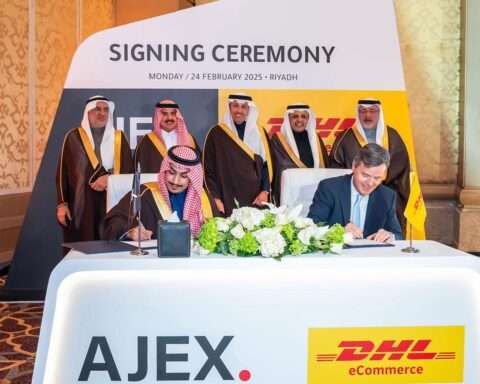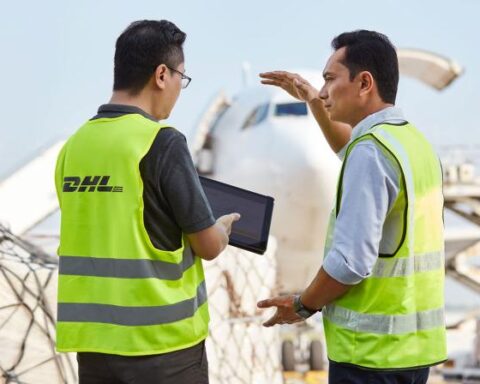No other logistics provider is investing anywhere near as much in e-mobility as Deutsche Post and DHL Parcel Germany.
Bonn,Berlin – A year ago, Deutsche Post DHL Group, the world’s leading logistics services provider, presented its Sustainability Roadmap and announced how Post & Parcel Germany plans to become more climate-friendly in its German operations. To showcase that the yellow brand is becoming greener, Deutsche Post today added the 20,000th e-vehicle to its delivery fleet, this time in Berlin. No other logistics provider is investing anywhere near as much in e-mobility as Deutsche Post and DHL Parcel Germany. The budget allocated for this year alone amounts to EUR 300 million.
Deutsche Post DHL is also investing a similarly large amount in the construction and refurbishing of climate-friendly operating sites. These include carbon-free delivery depots – 100 of which are scheduled for completion at the end of this year. Over the next two years, Post & Parcel Germany will be acquiring more than 400 (bio)gas-powered trucks to make transporting shipments between mail and parcel centers greener. In addition, the company is now offering a new portfolio of “GoGreen Plus” products, offering customers the chance to proactively manage and reduce their carbon footprint by choosing climate-friendly shipment by rail.
“In the course of the last twelve months, we’ve become even more climate-friendly across all of our logistics services – from our product portfolio to shipping, from our buildings to last-mile delivery,” says Tobias Meyer, CEO Post & Parcel Germany at Deutsche Post DHL Group. “We currently have the largest e-fleet in the logistics sector. Deliveries in over 50% of our delivery districts are now carbon-free, and our overall emissions are well below those of competitors. If conditions allow, sustainable, carbon-neutral post and parcel services can become a reality Germany-wide in the course of the next few years.”
New “green” product portfolio
Since as early as 2007, Post & Parcel Germany has offered its “GoGreen” service, allowing customers to offset the carbon emissions generated via certified climate protect projects. The projects carry Gold Standard certification and are selected for their benefit to the environment and the community in which they are located. For the past 11 years, every parcel shipped within Germany by a private customer has been automatically offset. The same is about to happen for private customers’ parcels and small packages sent abroad – these will be fully offset starting in summer this year. Since the start of the year, the carbon emissions generated in domestic and international mail shipments for private and business customers have also been offset at no extra charge.
With “GoGreen Plus”, the Group has created a product portfolio that allows business customers to avoid the emissions generated through a process known as “insetting” – this time investing in additional reduction measures in the logistics network. This involves initiatives like purchasing sustainable fuels and buying and deploying e-vehicles. Shipments sent using “GoGreen Plus” are completely carbon-neutral. A pilot with a small group of customers in the areas of national goods shipping as well as advertising and press services was launched in February this year, where a rollout to all customers is planned for 2023. A “GoGreen Plus” product for letter mail is expected to be announced in the second half of 2022.
Also, and with immediate effect, DHL’s “GoGreen Plus” portfolio offers private customers the option of using a free, optional freight train service to deliver their shipments by rail. They can now register their parcels via the DHL Online Franking portal or the Post & DHL App and have the option to select part of the transport route using the conventional way by truck or the new way by climate-friendly rail. Where suitable rail connections are available between the places of origin and destination, the new service can be used for parcels and small packages (size M) within Germany without an additional surcharge and can also be combined with selected services, such as shipment insurance. Rail freight is initially available on 144 of the longest railway lines between 37 DHL parcel centers in Germany. With additional connections planned for the future, the company aims to expand this climate-friendly parcel service to accommodate a greater number of shipments. Depending on the route, shipments sent via the new rail freight service can take up to a day longer than transports delivered by truck.
Climate-friendly shipping: 400 new (bio)gas-powered trucks, plus rail freight
At Post & Parcel Germany, carbon emissions are greatest when transporting shipments between the large mail and parcel centers. To remedy the situation, Deutsche Post DHL is purchasing more than 100 (bio)gas-powered trucks for use in its Post & Parcel Germany operations; additional vehicles will follow in 2023. In the future, the fleet will consist of more than 400 of these trucks. They generate far fewer emissions and are much quieter than trucks with diesel engines. Carbon emissions as well as nitrogen, particulate matter and particles are significantly reduced.
Shipping parcels by rail is another environmentally-friendly alternative for use on the main leg. Some 6% of the parcels volume is currently transported over long distances using railway lines between the places of origin and destination. This corresponds to 120 million parcels a year. Each DHL freight train transports up to 100,000 parcels, saving between 80 to 100 percent of carbon emissions compared with road transportation, amounting to an impressive 1,200 tons of carbon per month.
Carbon-neutral operations
Last year Deutsche Post DHL announced its plan to build 280 carbon-neutral delivery depots across Germany by 2025. Of these, 36 went into operation in 2021. The aim is to have 100 sites up and running by the end of this year. From these depots, the couriers distribute mail and parcels to homes in their delivery districts – mostly using e-vehicles, making deliveries carbon-neutral. The new company-built delivery bases will feature photovoltaic systems, heat pumps in conjunction with underfloor heating and building automation. At some sites, battery storage systems will supplement the energy efficiency model, while other sites have been retrofitting battery storage using the batteries of decommissioned StreetScooter e-vehicles.
In addition to these delivery depots, a series of construction projects took place in 2021. These involved existing Post & Parcel Germany buildings as well as new builds equipped with green solutions such as photovoltaics, green roofs and green facades. Just last November, the ground-breaking ceremony was held for Germany’s largest, most-sustainable mail sorting center in Germering, near Munich. Scheduled to go into operation at the end of 2023, it will provide jobs for 1,300 employees. The site will have a 1.5 Megawatt photovoltaics system, a battery store, and a green roof and facade. Heating and cooling will be provided via a geothermal heat pump. Post & Parcel Germany also generates carbon savings through the use of biogas and geothermal connections at its parcel centers. The share of green electricity used has long been stable at 95 percent. These examples illustrate how Deutsche Post follows a continuous, sustainable buildings strategy at its operational sites.
World’s largest e-utility fleet
Deutsche Post DHL continues to expand its climate-neutral delivery service for all shipment types. To date, this involves 20,000 e-trucks and some 12,600 e-trikes. In 2021, 63 million parcels were delivered using e-trikes alone in Germany. By 2025, the commercial e-fleet is set to grow yet further, comprising of 38,000 vehicles. The range of vehicles in the fleet is also being expanded to cover additional areas of application. In 2022 alone, 1,300 new StreetScooter Gigabox vehicles with a load capacity of 12 cubic meters will be deployed on Germany’s roads. Unlike the other models in the StreetScooter series, the Gigabox is a right-wheel drive, meaning that couriers enter and exit the vehicle curbside, improving both driver and road safety. The e-vehicle also has a walk-in storage space with shelving for around 160 parcels. By the end of 2022, the charging infrastructure at the company’s operational sites will be expanded from the current 24,200 to 28,000 charging stations.
Packstations playing an environment protection role
Another climate-friendly delivery option involves delivering parcels to Packstations. With some 9,300 Packstations installed, DHL has the widest network of parcel vending machines in Germany by far, which also benefits the environment. Compared to doorstep delivery, Packstation shipment reduces carbon emissions by an average of 30% over the last mile. This is because the courier can deliver and also collect several dozen parcels per stop at a Packstation. Deutsche Post DHL plans to increase the number of Packstations in its network to 15,000 by the end of 2023. In March of this year, Deutsche Post DHL announced that in cooperation with Deutsche Bahn, 800 Packstations will be installed at railway stations – most of them in the course of this year. The expansion also includes an increase in the number of app-controlled Packstations. These are powered by solar panels, helping to cut carbon emissions and meet the company’s reduction targets.
Best wages and working conditions
Deutsche Post DHL places great importance on climate protection, but sustainability also involves social elements. In addition to paying the highest wages in the logistics sector, Deutsche Post DHL offers employees a wide range of development opportunities, modern workplace equipment and resources, and a broad-based occupational safety and health management program. At Deutsche Post AG, the entry-level hourly wage for couriers now lies at between EUR 12.60 and EUR 14.30. The average hourly wage for more experienced couriers lies at just under EUR 19. These figures are all the more impressive because Post & Parcel Germany’s competitors warned against introducing a minimum hourly wage of EUR 12, saying it would force a cut in jobs. Deutsche Post believes that by adopting this business model, many postal service providers can only really work by undercutting wages and adopting subcontracting structures.
Policy conditions needed for a universal, carbon-neutral mail and parcel service
The examples cited above illustrate how much Deutsche Post DHL invests in sustainability to ensure a sustainable future for its customers, its employees and for society overall. But investments must also pay off for private businesses. Market conditions will dictate whether and to what extent a business model proves viable, driving Germany’s ability to provide a universal, carbon-neutral mail and parcel service. “What we repeatedly find is that in practice, sustainability plays no role in public sector procurement,” says Meyer. “Contracts are awarded solely on grounds of price. We’d really like to see the German government make good on its announcement in the coalition agreement, that the Postal Act will be revised in line with criteria focusing on environmental and social components.”






